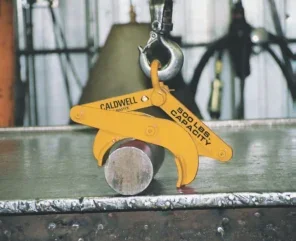
Lifting tongs are one of the earliest lifting devices put to use. Given that the conceptual design uses the universal law of physics to achieve a certain capacity, civilisation has been using this concept for thousands of years. Pivot points are a trait of every tong, for example.
In other words, a lifting tong is a mechanical device that utilises a series of linkages to obtain an appropriate amount of force, depending on the application. They commonly fall into the run-ofthe- mill design category, similarly to an industrial lifting beam or coil hook. Here in the U.S., that means BTH design category B and service class 2 are in play. However, they can be designed lighter or heavier, depending on the environment.
Lifting tongs are somewhat unique in that they can be used for almost any load in a wide variety of sizes. Conversely, other products, many of which we’ve explored here in this column, are designed for a very specific purpose. It means that tongs have a wide capacity range, from less than 50 lbs. (approx. 23 kg) up to 50 tons. And they can be used in conjunction with limitless material handling tools and technologies, including jib, workstation, overhead bridge, and small davit cranes.
This variety means that oftentimes, an alternative solution is sought, when a lifting tong would be the preferable way to solve a problem. For instance, we continue to see lifting chains or synthetic straps used where a tong would be safer and more efficient.
While manufacturers of lifting tongs have a number of standard products (for handling pipes, dies, etc.) the vast majority of the tongs designed today are customised to fit the particular lift requirements. Tongs are thusly very specific to an end-use scenario and are generally rigid in physical sizes that can be lifted. Any deviation can often put the load outside of a ‘safe lift’ for that tong as originally designed.
Like overhead lifters, the weight of the lifting tong needs to be factored in when suspending it from any type of crane or hoist. Space is another critical factor; the operator must be able to get around the item being lifted. Many users think of it in terms of making sure there is ample aisle space to work with. As an example, you cannot get a tong around a product that is tightly packed in a crate or on a pallet. This should be planned into the wider production line or operation.
TONG TYPES
While people talk about friction, indentation, and supporting lifting tongs, there are only two main types — pressure (friction) and supporting — although in rare cases there is a necessity to manufacture a product that is a combination of both.
The need arises for a pressure (friction) lifting tong when it is otherwise impossible or not desirable to get underneath the product being lifted, as you would do with a supporting lifting tong. Supporting tongs are used when the load being lifted is fragile and could be damaged by the supporting pressure of the gripping tong. The term indentation issomewhat misleading here because we typically consider this as supporting style, perhaps with a little bit of friction as part of the tool. But this doesn’t happen often.
Without getting too technical, it wouldn’t be sensible to use a supporting tong to lift rolls, tubes, and other cylindrical materials because a circular shape, by nature, makes it extremely difficult, or impractical, to support the load, especially when it comes to keeping the load stable. Further, if you’re lifting a delicate load, a supporting tong would be better than an alternative.
Simple principles endure to always source the right tool for the job at hand. Our Rig-Master line is perfect for outdoor construction or infrastructure projects where pipe is being handled or precast concrete products are being moved around. Regardless of location, users must check the lifting bail for irregular wear. Additional inspection is required of the latching (hold open/hold closed) device; bolts; general wear of holes at the pivot points; and excessive wear or abuse of the gripping pads.






